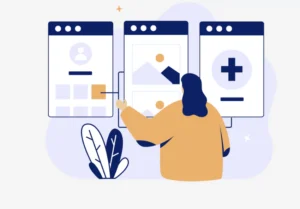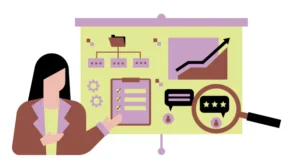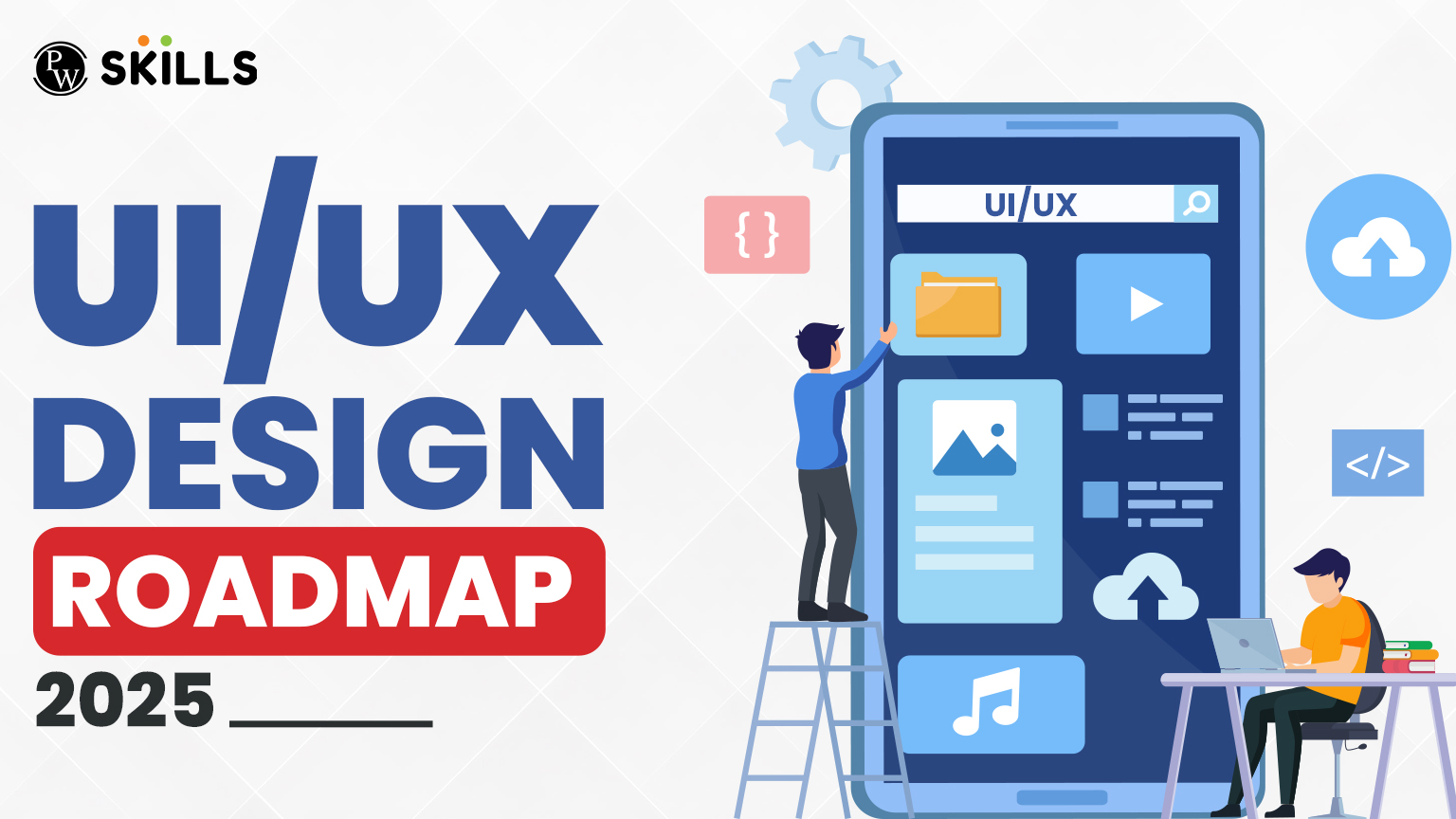Introduction: Why UI UX Design Still Rules in 2025
Speaking of 2025, there is a need to focus more on the seamless creation of digital experiences. UI talks about what a product looks like while UX focuses on the feel and the function of how users interact with the apps and websites. All of this is UI UX design. This UI UX design roadmap 2025 serves as the guide to use, whether students are just taking those first courses or professionals who want to switch from their paths.

Step 1: Understand UI UX Basics
Start by understanding the real meaning of UI UX design. While UX involves user research, customer journey mapping, product wireframes, and prototypes. UI involves colors, fonts, layouts, and visuals. Learn that solving problems is what matters and not merely making things look good. Read up on usability and accessibility. Then the rest will comfortably fall in places. Look into:
UX Concepts:
- User research techniques (interviews, questionnaires)
- Empathy mapping
- User journeys & experience flows
- Information architecture
- Usability heuristics (Nielsen’s 10 rules)
UI Concepts:
- Visual hierarchy
- Typography and font pairing
- Color theory and accessibility
- Iconography
- Design systems and pattern libraries
Tip: Read up on case studies from Medium, design with accessibility in mind and always ask: Will my design simplify users’ lives?
Step 2: The right tools for UI UX design
Design tools are your co-traveller in this journey. Start with Figma and Adobe XD for interface design and prototyping, miro or whimsical must be preferred for mapping concepts. As for Adobe tools, Photoshop and Illustrator are good ones for icons and images. Do small projects to get practical experience while learning these tools. Following the UI UX design roadmap 2025 means that you feel comfortable working with design tools.
First, start with free versions and gradually move toward advanced tools.
- Figma- An all in one tool for UI, UX, wireframing, and prototyping
- Adobe XD- Seamless transitions while prototyping with animation
- Sketch- Preferred among many UI designers on Mac
- InVision- Awesome to create clickable prototypes and share them
- Miro / Whimsical- Whiteboarding & brainstorming
Design Asset Tools:
- Illustrator / Photoshop- For icons, illustrations, and image editing
- LottieFiles- For animation
Best practices:
- Create reusable components
- Learn auto-layout and constraints
- Version control for collaborative projects
Pro tip: Don’t fall for “the tool trap.” Master one tool before going on to the next.

Step 3: Get Some Real Projects in Your Portfolio
Use your skills on some mock or real-life projects. These can concern redesigning popular apps or addressing a problem in your local business. Have research, ideation, wireframes, and final UI in your case study. Put your work on LinkedIn and Behance. These projects will bring your UI UX roadmap to life and give you the necessary ammunition to get a job. Learn through crafting projects more like the real world:
Project Ideas could be:
- Redesign banking app UI
- Create a new onboarding flow for a fitness app
- Enhance an NGO website for better donation usability
- Design a responsive travel blog layout
How to structure a case study:
- Defining the Problem
- Sharing research insights
- Mapping user flows and personas
- Building wireframes and testing ideas
- Delivering final UI designs with explanation
Tip: Put your work up on Behance or LinkedIn, and publicly ask for feedback—this will bolster your confidence and give you some networking opportunity.
Step 4: Learn about Users (Because They Matter Most)
Design is not about you; it is about the user; conduct interviews, surveys, or usability tests to dive deep into real needs of users; develop personas, journey maps; and test your design bearing users in mind. The insights you gather with the help of Hotjar or Google Forms would be great. User research is the soul of UI UX design roadmap 2025.
Master the art of understanding human behavior.
User Research Techniques:
- Usability Testing (observe users while using your design)
- A/B Testing on two different layouts
- Open-ended Interviews
- Diary Studies (users note their experiences)
Persona Development:
- Define goals, frustrations, behaviors, and tech habits
- Use Empathy Maps to visualize emotional states
- Segment users by demographics and intent
Journey Mapping Essentials:
- Mark every step of user engagement
- Identify Pain Points
- Identify “Wow” Moments
Golden Rule: You are not your user. Always test your assumptions.

Step 5: Stay Updated and follow Trends
Designs are changing every day. There’s always something fresh to catch up with, whether it’s about dark mode, micro-interactions, or voice interfaces. Watch YouTube design channels, blog read, and listen to design podcasts. Join in UX communities to keep yourself inspired. For the modern designer, learning is an unceasing journey. Keep updating your UI UX roadmap with fresh ideas.
![]() Join Our UI/UX Telegram Channel
Join Our UI/UX Telegram Channel
![]() Join Our UI/UX WhatsApp Channel
Join Our UI/UX WhatsApp Channel
Current hot topics to work on:
- Voice UX (VUX) for intelligent devices
- Gesture-based design (for wearables & AR)
- AI-based adaptive design
- Neumorphism & Glassmorphism (visual trends)
- Designing for emotion and mental health
Resources to follow:
- Newsletters: UX Design Weekly, Sidebar.io
- Podcasts: Design Better, Wireframe
- YouTube: Jesse Showalter, AJ&Smart
- Books: “Don’t Make Me Think” by Steve Krug,” The Design of Everyday Things “by Don Norman.
Tip: Attempt redesigning an old-fashioned application according to the standards of 2025; notice how much more intuitive it feels to use.
Step 6: Soft Skills Compliments Your Design Skills
Master the art of making presentations and accepting feedback. Share ideas and communicate with the developers, the marketers, and the product team. Get into team projects or hackathons for the sake of improving your teamwork. Being a good team player adds to your journey toward UI UX design roadmap 2025. Designers rarely work alone. You will work with stakeholders, developers, and marketing teams.
Important Soft skills:
- Active listening & feedback handling
- Clear communication of your design decisions
- Time management in iterative sprints
- Conflict resolution when ideas clash
Step 7: Internships, Jobs & Freelancing
While applying for internships and jobs you must need a platform to showcase your skills there you can use platforms like LinkedIn, Upwork, or Behance. Ask for reviews and feedback. Start by small projects, but stay consistent. This brings your UI UX roadmap into actual professional growth.
Portfolio Must-Haves:
- 3-4 strong projects with complete UX Case Studies
- Clean UI screens with their mobile + desktop views
- Summary of your role, tools used, and challenges solved
Job Hunt Checklist:
- Optimize LinkedIn and Behance
- Be ready with a 2-minute portfolio walkthrough
- Keep short cover letters ready for every application
Freelancing Platforms to Explore:
- Upwork
- Fiverr
- Toptal (for experienced designers)
- LinkedIn Jobs
- Local business pages for cold pitching
Tip: Always ask for testimonials from internships or freelance clients. Social proof builds trust.

Learning Resource
If you are completely new to the space, do not worry-you are not alone. UI UX design seems daunting at first, and the best option for you, in terms of pulling through, would be to enroll for a beginner’s course that would allow you the opportunity to structure your learning, build confidence, and get hands-on experience. Such courses also help build projects sought by recruiters. For many, taking such a course becomes the shortcut to learn the basics of UI UX.
Also Read:
- 8 UX Design Process: An Effective Beginner& Guide to Creating User-Friendly Products
- AI in UX Design: Effective Tools Transforming the Future of User Experience
- What Is a UX Researcher? Skills, 2 Effective Methods, Salary & How to Get Hired
- What Is UI Design Certification? A Complete Guide for Aspiring Designers
Go For PW Skills UI UX Course
PW Skills provides hands-on UI UX training, which is ideal for absolute beginners and working professionals. You will learn about real-world project assignments through industry-standard tools like Figma, Adobe XD, and Miro. The syllabus framework will cover everything and most importantly, focused on jobs-perfect for a bright start in your career in design.
FAQs
How long does it take to become a UI UX Designer in 2025?
With consistent learning and practice, you can become job-ready in 4–6 months through courses, self-study, and portfolio projects.
Can I become a UI UX designer without coding knowledge?
Yes, UI UX design focuses on visuals and user experience. While understanding tech helps, coding isn't required for most roles.
What makes a good UI UX portfolio in 2025?
A good portfolio includes 3–4 strong projects, user research, clean visuals, and case studies that show your design thinking clearly.

